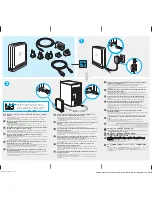
Chapter 8: Encoding
188
Video Data Rate Options
Video Data Rate options let you specify how Cleaner constrains the movie to the data rate you
choose. The selected architecture and codec determine the options available to control the data
rate. Cleaner disables data rate control options that do not work with the selected codec.
•
Basic
— Cleaner uses the built-in data rate controls of the codec, if any. Basic control is the
behavior you get with most QuickTime programs via the standard QuickTime compression
dialog.
•
Suppress Spikes
— (Available only if Sorenson Video Pro is installed.) Encodes a movie at
a fixed quality setting, but does not allow the data rate to peak over the entered value. The
Suppress Spikes option is a single-pass approach that eliminates problematic data rate
spikes with supported codecs. Because it is a single-pass approach, the Suppress Spikes
option is faster than 2-pass VBR, but generally does not produce results that look as nice.
However, this option may produce better results than the Flat or Basic options with some
material. The Suppress Spikes option often produces a lower average data rate than the
number entered in the Limit to field because this value is the peak, not average, data rate. If
average data rate control is a major concern, use the 2-pass VBR option.
•
Flat
— (Available only if Sorenson Video Pro is installed.) Cleaner attempts to control frame
size to keep the data rate uniform throughout the movie. The flat data rate is an average of
one second. To maximize image quality, the keyframes are larger and the delta frames
smaller. Generally, this is not the optimal way to encode a movie. The Suppress Spikes or 2-
pass VBR options generally provide superior results.
•
CBR
— (MPEG-1, MPEG-2 only) Uses a fixed data rate throughout the entire file. This is
useful when you are limited to a maximum file size for the output clip (such as VideoCD).
•
1-pass VBR
— The 1-pass VBR (Variable Bit Rate) option varies the bit rate intelligently over
the length of the clip. Portions of the video which have less motion are typically allocated a
smaller part of the file, because they compress more easily. Segments with a great deal of
motion are allocated a larger bit rate, as they are harder to compress. The result is a more
consistent video quality while providing a smaller file size than CBR.
•
2-pass VBR
— The 2-pass VBR (Variable Bit Rate) option is available for a number of codecs,
such as Real 10, QuickTime, Flash, DivX, MPEG-1, and MPEG-2. Two passes are used to
intelligently control the data rate of a movie. In the first pass, Cleaner analyzes the entire
movie to locate “hard” and “easy” sections. After it understands the movie, Cleaner starts
its second pass to encode the movie. In this encoding pass, Cleaner uses lower average data
rates in the easy sections and higher average data rates in the hard sections. Although the
total data rate of the final output is identical to the same movie encoded using a constant
bitrate technique, the final results generally look substantially better. 2-pass VBR produces
the most notable gains in quality in movies that have intermixed hard and easy sections.
Because the movie is first analyzed and then encoded, 2-pass VBR files take longer to encode
than constant bitrate encoding.
Содержание 64006-051108-9001 - Discreet Cleaner - Mac
Страница 1: ...from discreet November 2000 ...
Страница 8: ...Contents viii ...
Страница 16: ...Chapter 1 Introduction 8 ...
Страница 24: ...Chapter 2 Capture 16 ...
Страница 54: ...Chapter 4 Projects 46 ...
Страница 68: ...Chapter 5 Settings 60 ...
Страница 148: ...Chapter 7 Formats 140 ...
Страница 160: ...Chapter 8 Encoding 152 ...
Страница 220: ...Chapter 8 Encoding 212 ...
Страница 248: ...Chapter 11 Workflow 240 ...
Страница 254: ...Chapter 12 Troubleshooting 246 ...
Страница 284: ...Glossary 276 ...
















































